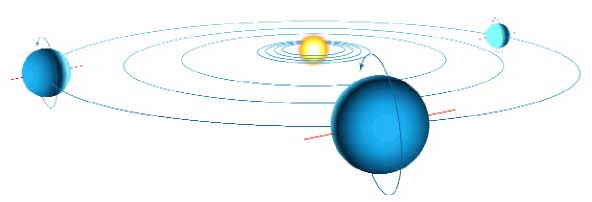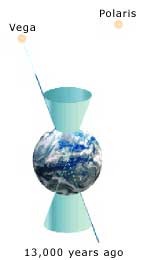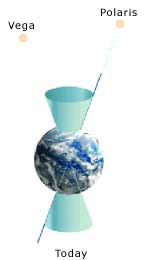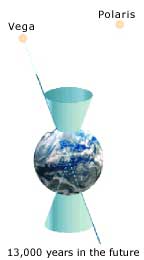 |
A Severely Tilting Planet
Most of the other planets in the solar system spin more or less like tops as they travel around the Sun, but Uranus tilts severely, circling with its axis of rotation nearly parallel to its orbital plane. One result of this orientation is that its polar regions alternately point directly at or away from the Sun. In the course of the planet's 84-Earth-year orbit, the poles endure 42-year days and nights. Scientists think that an Earth-sized object might have smashed into Uranus early on, knocking it on its side. |
   |
Earth's Precession
The gravitational pull of the Sun and Moon on Earth's equatorial bulge causes Earth's rotational axis to gyrate around the vertical, tracing a cone in space over a period of 26,000 years. The pole star to which the axis points today is Polaris. Thirteen thousand years ago Earth's axis pointed to Vega, in the constellation Lyra, as it will again 13,000 years from now. Precession was the third-discovered motion of the Earth, after the far more easily observed daily rotation and annual revolution. |
|
Earth's axis points in the northern sky at Polaris, a moderately bright star at the end of the Little Dipper's "handle." That will change as precession swivels Earth's axis on a slow arc through the sky. In 13,000 years, Earthlings will have a dazzling beacon as their north star, the bright star Vega.
Rapid spin imparts another desirable property to an object. In the absence of other forces, it keeps the axis of rotation pointing in the same direction. To use a recreational analogy, try to hurl a Frisbee without spinning it. It will flutter embarrassingly to the ground. But a quick snap of the wrist sends the disk on a steady rotating flight through the air. Spinning bicycle wheels also are much more stable than stationary ones, as any cyclist can attest. Spacecraft designers take advantage of this property in two ways. Some satellites and space probes spin several times each minute, good enough to keep their communications antennas aimed at Earth and to prevent them from tumbling through space. Orbiting telescopes require a more accurate aim. Those spacecraft carry at least three small gyroscopes, each aligned perpendicular to the other two. Guidance systems use the combined motions of the gyroscopes to hold the satellites still, allowing mission controllers to point them with great accuracy.
Like spinning basketballs and satellites, rocky planets are rigid rotators. To maintain their shapes, all parts of the objects make complete turns in the same amount of time. This means that a point on the surface has zero speed at the axis of rotation. At the object's equator (the belt most distant from the rotation axis) the surface speed reaches a peak. On Earth that's 1,040 miles per hour, modest by cosmic standards. Most launch pads are close to the planet's equator, rather than the poles, to give rockets an extra boost of speed on their climbs into orbit.
Earth and other rigid rotators are strong enough to withstand the internal stresses that otherwise would shear the objects apart as they spin. However, the universe is full of rotating bodies that aren't rigid at all. A star is one example--it's a bloated ball of gas with little stiffness. A stirred mug of coffee is another. It's easy to notice that the coffee near the center of the mug rotates at a rate altogether different from the coffee near the rim. If you need a visual aid, dribble some cream from the mug's center to the edge. If the coffee rotated as one solid unit, like Earth, the cream would remain intact in a fuzzy line. Instead it stretches into strands and loops that spin at varying rates. This shearing action is called "differential rotation." |

